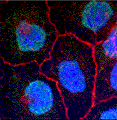Biochemistry, Department of
Document Type
Article
Date of this Version
2001
Abstract
Wild-type Chlamydomonas reinhardtii cells shifted from high concentrations (5%) of CO2 to low, ambient levels (0.03%) rapidly increase transcription of mRNAs from several CO2-responsive genes. Simultaneously, they develop a functional carbon concentrating mechanism that allows the cells to greatly increase internal levels of CO2 and HCO3. The cia5 mutant is defective in all of these phenotypes. A newly isolated gene, designated Cia5, restores transformed cia5 cells to the phenotype of wild-type cells. The 6,481-bp gene produces a 5.1-kb mRNA that is present constitutively in light in high and low CO2 both in wild-type cells and the cia5 mutant. It encodes a protein that has features of a putative transcription factor and that, likewise, is present constitutively in low and high CO2 conditions. Complementation of cia5 can be achieved with a truncated Cia5 gene that is missing the coding information for 54 C-terminal amino acids. Unlike wild-type cells or cia5 mutants transformed with an intact Cia5 gene, cia5 mutants complemented with the truncated gene exhibit constitutive synthesis of mRNAs from CO2-responsive genes in light under both high and low CO2 conditions. These discoveries suggest that posttranslational changes to the C-terminal domain control the ability of CIA5 to act as an inducer and directly or indirectly control transcription of CO2-responsive genes. Thus, CIA5 appears to be a master regulator of the carbon concentrating mechanism and is intimately involved in the signal transduction mechanism that senses and allows immediate responses to fluctuations in environmental CO2 and HCO3 2 concentrations.



Comments
Published in PNAS, April 24, 2001, vol. 98, no. 9, 5341–5346. Used by Permission